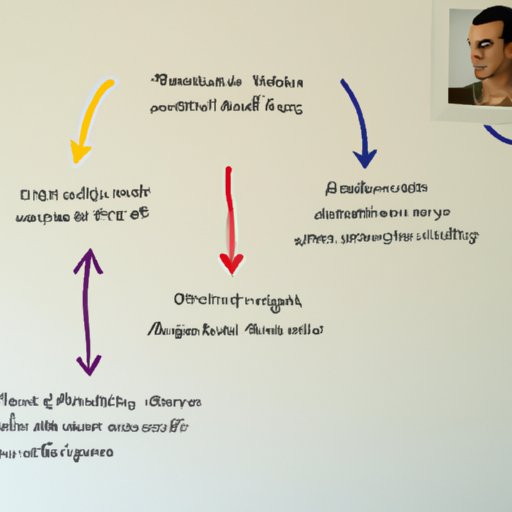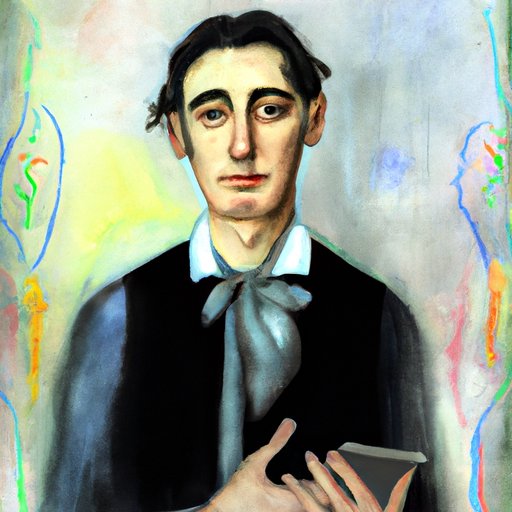Introduction
James Joyce’s A Portrait of the Artist as a Young Man is a classic coming of age novel that follows Stephen Dedalus, an Irishman struggling to find his place in the world. Through his story, Joyce explores themes of identity, religion, and self-discovery. This article will examine these themes in depth, exploring how they shape Stephen’s character arc and the symbolism of language in the novel.

Analyzing the Character Arc of Stephen Dedalus
Stephen’s journey is one of self-discovery and growth. He begins as a young man searching for his identity and struggling with religious dogma, and emerges at the end of the novel as an independent artist. Throughout the story, he faces many challenges and learns important lessons about himself and the world around him.
His Search for Identity
At the beginning of the novel, Stephen is a confused and lonely young man who feels out of place in his environment. He is caught between two worlds—the traditional Irish culture of his family and the modern world of art and literature. As he searches for his identity, he faces a number of difficult questions about his place in the world. “Who am I? What is my purpose? Where do I belong?”
His Struggle with Religion
Stephen also struggles with his faith. He was raised in a devout Catholic home and has been taught to adhere to the strict beliefs of the Church. But as he grows older, he begins to question these teachings and rebel against them. He finds himself drawn to the new ideas of modernism and atheism, which challenge the authority of the Church.
His Growth and Development
Throughout the novel, Stephen undergoes a transformation. He begins as a timid and compliant boy, but gradually grows into a confident and independent man. He learns to stand up for himself and make his own decisions, regardless of what others may think. By the end of the novel, Stephen has found his identity and is ready to take on the world.
An Examination of the Role of Religion in A Portrait of the Artist as a Young Man
Religion plays a major role in Stephen’s life. It shapes his thoughts, feelings, and decisions. As he navigates his way through adolescence, he must confront the conflicting forces of faith and doubt.
The Church’s Influence on Stephen
The Church exerts a powerful influence on Stephen’s life. Its teachings dictate his actions and determine his moral code. He believes in its doctrine and fears its punishments. Yet at the same time, he is drawn to the freedom of thought and expression that atheism offers.
Religion as a Source of Conflict
Stephen’s struggle between faith and doubt leads him into conflict with those around him. His family and friends are devout Catholics, while he is questioning the teachings of the Church. This causes tension and unrest in his life, as he grapples with the opposing forces within him.
Stephen’s Search for Spiritual Autonomy
Ultimately, Stephen’s journey is one of spiritual autonomy. He seeks to define his own beliefs and come to terms with his own truth. By the end of the novel, he has learned to stand on his own two feet and make his own choices, without relying on the beliefs of others.

Exploring the Coming of Age Narrative in A Portrait of the Artist as a Young Man
The novel follows Stephen’s coming of age story, as he moves from childhood to adulthood. Along the way, he faces many obstacles and learns important lessons about life and himself.
Themes of Self-Discovery
One of the main themes of the novel is self-discovery. Stephen embarks on a quest to find himself and uncover his true identity. He must learn to accept his flaws and weaknesses, as well as his strengths and talents. He discovers that he can be both an Irish Catholic and a modern artist, and that he can reconcile the two sides of himself.
Overcoming Adversity
Stephen also learns to overcome adversity. He faces many challenges on his journey—from bullies to religious persecution—but he perseveres and finds his own path forward. He learns to stand up for himself and fight for what he believes in.
Finding a Path Forward
By the end of the novel, Stephen has found his place in the world. He has discovered his identity and forged his own path. He is no longer bound by the expectations of his family or society, but is instead focused on his own goals and ambitions.
Themes of Identity and Self-Discovery in A Portrait of the Artist as a Young Man
Identity and self-discovery are key themes in the novel. Stephen’s journey is one of inner exploration and growth, as he seeks to understand himself and find his place in the world.
Stephen’s Internal Struggles
Stephen’s internal struggles shape his character arc. He is torn between two worlds—his traditional Irish upbringing and the modern world of art and literature. He must reconcile these two sides of himself if he is to find his identity and move forward with his life.
His Quest for Self-Knowledge
In order to find his identity, Stephen must embark on a quest for self-knowledge. He must confront his fears and doubts, and come to terms with his past. He must learn to trust himself and make his own decisions, without relying on the opinions of others.
His Evolution from Childhood to Adulthood
Through his journey, Stephen evolves from a confused and insecure boy to a confident and independent man. He learns to stand on his own two feet and take control of his life. By the end of the novel, he has found his identity and is ready to take on the world.

Examining the Symbolism of Language in A Portrait of the Artist as a Young Man
Language is an important theme in the novel. Stephen uses words to express his thoughts and feelings, and to explore the world around him. He discovers the power of language and the potential it holds to transform his life.
The Power of Words
Words have the power to shape our thoughts and emotions. Stephen learns this lesson early on, as he discovers the transformative power of language. He comes to understand that words can be used to create and destroy, to inspire and oppress.
Stephen’s Use of Language to Express Himself
As Stephen grows older, he begins to use language to express himself. He writes poetry and stories, exploring his innermost thoughts and feelings. Through his writing, he is able to make sense of his life and come to terms with his past.
The Role of Language in His Journey
Language plays an important role in Stephen’s journey. It is his tool for self-expression and exploration. By using words to express himself, he is able to gain insight into his true identity and find his place in the world.
Conclusion
In A Portrait of the Artist as a Young Man, James Joyce explores the themes of identity, religion, and self-discovery. Through the character arc of Stephen Dedalus, he examines the struggles of growing up and finding one’s place in the world. He also examines the role of language in the process of self-discovery, demonstrating its power to shape our lives. The novel is a timeless exploration of the human experience, and its themes remain relevant today.
Summary of Key Points
This article examined the themes of identity, religion, and self-discovery in James Joyce’s novel A Portrait of the Artist as a Young Man. It explored Stephen’s character arc and the role of religion in his life, as well as the coming of age narrative and the symbolism of language in the novel.
Takeaways
This article revealed the complexity of Joyce’s novel and the richness of its themes. It demonstrated the power of language to shape our thoughts and emotions, and highlighted the importance of self-discovery in the process of growing up. A Portrait of the Artist as a Young Man is a timeless exploration of the human experience, and its messages remain relevant today.
(Note: Is this article not meeting your expectations? Do you have knowledge or insights to share? Unlock new opportunities and expand your reach by joining our authors team. Click Registration to join us and share your expertise with our readers.)
